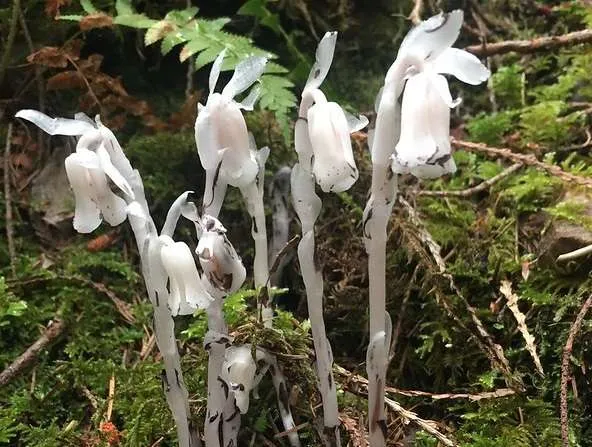Out In The Woods
- July 26th 2024
- Out in the Woods

The tiny scales on the stem are actually leaves
Photo: ramapithecus via Creative Commons
Ghost Pipes: Pretty White Forest Parasites
By Kevin McKeon, Maine Master Naturalist
They’re white, look like they should be a mushroom, have a flower and produce seeds. They have no chlorophyl, so they don’t photosynthesize. When noticed by Sanford trail walkers, they often stop and ask, “what exactly are ghost pipes?” They’re perennial woodland flowers, an herb, related to the rhododendron and blueberry. They like dark places, so look for them in a forest area with dense, moist, rich soil.
Poking up from leaf litter in the shade, near an oak or beech tree, ghost pipes, Monotropa uniflora, are 2” to 12” tall with a single pendulous (drooping) flower that blooms from early summer to mid-autumn, often after wet weather. After pollination—usually by a bumble bee—it straightens and turns slightly pink. As the seeds mature, an oval-shaped fruit capsule forms and the plant begins to turn almost black. When mature, the capsule splits, and the tiny seeds disperse in the wind.
The very small “scales” along its stem are actually the flower’s leaves. But, like over 3,000 other plants, it doesn’t make its own food. So how does it survive? Well, some science teachers get their students’ attention by using the term “ménage à trois!” (It’s OK; this is “G”-rated—your kids can read this!).
It all begins with the roots of trees and various mushrooms seeking and finding each other by chemical signals, then bonding. The mushroom’s roots are tiny white threads called mycorrhizae, forming a massive underground network so extensive that there are 300 miles of it under one of your feet! The tree gives some of the food it photosynthesizes to the mushroom roots and the mushroom roots give the tree water and mineral food from the soil, forming a symbiotic relationship
Now, for the “ménage à trois” and where the ghost pipes enter the equation. The ghost pipe’s roots mimic the tree’s roots, tricking the roots — or mycorrhizae — of certain mushrooms into attaching to it. So now, the ghost pipe receives food via this new root connection from both the tree and the mushroom. Neither the tree nor the mushroom seems to know about it. If they did, they couldn’t do much about it anyway. The ghost pipe gives nothing to either one of them in return, making it a parasite…but a pretty one!
The two species of mushrooms favored by the ghost pipes are known to have caused human deaths. The active chemicals within these mushrooms seem to have made their way into the ghost pipes, but in a slightly modified way. Knowledgeable and trained herbalists make a tincture from ghost pipes that may provide health benefits for epilepsy, physical, and psychological pain. But this plant contains neurotoxins that can be deadly. Observe these pretty parasites all you want but realize that it’s best, for them and you, to leave them anchored in their home soil, connected to the trees and mushrooms.






